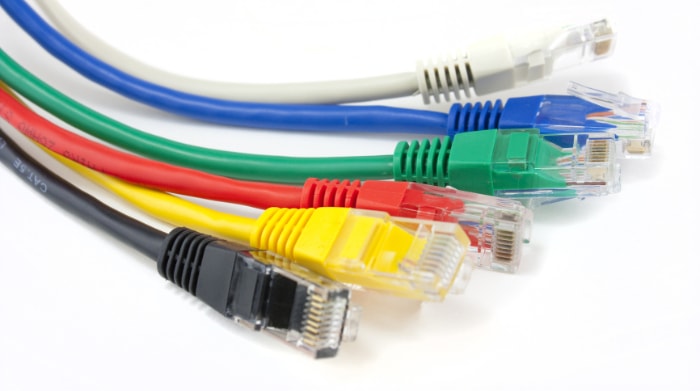Best Ethernet Cables for Streaming: The Power of Speed

Streaming high-quality content smoothly and reliably demands more than just a speedy internet connection; it requires a robust and stable link between your streaming device and the network source. Ethernet cables, often overlooked, play a crucial role in this setup, offering a level of consistency and speed that Wi-Fi struggles to match.
Whether you’re a gamer, a live streamer, or simply enjoy binge-watching your favorite shows, understanding the significance of the right Ethernet cable can transform your streaming experience from good to great.
Let’s explore how these cables work, what makes them different, and most importantly, how to choose the best one for your streaming needs.
Basics of Ethernet Cables
Ethernet cables are the lifeline of a wired network connection, serving as the physical conduit through which data travels between devices and the internet. They are a key component in a home or office network, especially when stability and speed are paramount.
What Are Ethernet Cables?
Ethernet cables, broadly classified as network cables, are used to connect devices within a local area network (LAN), such as PCs, routers, and switches. These cables facilitate the transfer of data at high speeds over short and medium distances.
They are designed to handle various types of data, including video and voice signals, making them versatile for different applications.
Types of Ethernet Cables
There are several types of Ethernet cables, each with its unique specifications and capabilities. The most common types include:
- Cat5e (Category 5 enhanced): An advancement over the Cat5 cable, offering speeds up to 1 Gbps with a frequency of up to 100 MHz.
- Cat6 (Category 6): Designed for performance up to 10 Gbps with a frequency of up to 250 MHz, making it more suitable for environments with higher network demands.
- Cat7 (Category 7): Offers performance up to 10 Gbps with a significantly higher frequency of up to 600 MHz. It also features improved shielding for reduced signal interference.
- Cat8 (Category 8): The latest and most advanced, supporting data speeds up to 40 Gbps with a frequency of up to 2000 MHz.
Construction and Shielding
The construction of Ethernet cables typically involves multiple twisted pairs of copper wires, which help reduce interference and crosstalk. Shielding is an additional layer of protection found in some Ethernet cables, further minimizing electromagnetic interference.
This shielding is especially important in environments with a high degree of electronic noise.
Importance of Bandwidth and Data Transfer Rate
The bandwidth and data transfer rate of an Ethernet cable determine how much data it can carry and how quickly. Higher categories of Ethernet cables support higher bandwidths, translating to faster data transfer rates.
This is crucial for activities like streaming, gaming, and transferring large files, where speed and stability are essential.
Why Ethernet Over Wi-Fi for Streaming?
Choosing between Ethernet and Wi-Fi for streaming is a decision that impacts the quality and consistency of your online experience. While Wi-Fi offers the convenience of wireless connectivity, Ethernet brings unparalleled stability and speed.
This is particularly crucial for streaming, where even minor disruptions can significantly affect the experience.
Stability and Reliability
Ethernet connections are known for their stability. Unlike Wi-Fi, which is susceptible to various forms of interference (like walls, other electronic devices, and even microwave ovens), Ethernet provides a direct and uninterrupted path for data transmission.
This direct connection minimizes packet loss – a critical factor for seamless streaming of high-definition content.
Speed and Bandwidth
Ethernet cables generally offer faster speeds compared to Wi-Fi. The latest categories of Ethernet cables, such as Cat6, Cat7, and Cat8, are capable of supporting gigabit speeds, far surpassing the average capabilities of most home Wi-Fi networks.
This high bandwidth is particularly beneficial for streaming high-resolution video and handling multiple streams simultaneously without buffering.
Lower Latency
Latency refers to the time it takes for data packets to travel from one point to another. In streaming, lower latency is desirable for real-time playback and synchronization of audio and video.
Ethernet connections typically have lower latency compared to Wi-Fi, which can fluctuate due to signal strength variations and interference.
No Wireless Interference
Wi-Fi networks operate on specific frequencies, like 2.4 GHz or 5 GHz, and are prone to interference from other devices using the same frequencies.
This can lead to inconsistent signal strength and quality. Ethernet, being a wired connection, is immune to this type of interference, ensuring a more consistent and reliable connection for streaming.
Security
While not directly related to streaming quality, it’s worth noting that Ethernet connections are generally more secure than Wi-Fi. Since Ethernet requires physical access for connectivity, it is less prone to hacking and other wireless security threats.
Factors to Consider When Choosing an Ethernet Cable for Streaming
Selecting the right Ethernet cable for streaming is crucial to ensure a high-quality, uninterrupted viewing experience. While it might seem like a simple task, various factors come into play that can significantly influence performance.
Cable Category
The category of the Ethernet cable is one of the most critical factors. Different categories offer varying speeds and bandwidth capabilities:
- Cat5e: Suitable for speeds up to 1 Gbps, ideal for basic streaming requirements.
- Cat6: Supports up to 10 Gbps, a good choice for high-definition video streaming.
- Cat7 and Cat8: Provide even higher speeds and bandwidth, best for ultra-high-definition and 4K streaming.
Selecting a higher category cable ensures better future-proofing as internet speeds and streaming quality continue to improve.
Length of the Cable
The length of the Ethernet cable can affect the signal quality. Longer cables can lead to potential signal degradation. It is advisable to use the shortest cable possible to connect your device to the network source.
However, if a long cable is necessary, ensure it is of high quality and preferably a higher category to minimize signal loss.
Shielding and Build Quality
Shielding is an essential aspect of Ethernet cables, especially in environments with a lot of electronic devices. Cables with proper shielding protect against electromagnetic interference, maintaining signal integrity.
Additionally, the overall build quality of the cable, including the durability of the outer jacket and the quality of connectors, plays a vital role in the cable’s longevity and performance.
Compatibility With Existing Equipment
Ensuring compatibility with your current networking equipment is essential. This includes compatibility with your router, modem, and any network switches or hubs in your setup.
A cable that exceeds the capabilities of your existing hardware will not improve your streaming experience beyond the limits of the hardware.
Price and Brand Reputation
While it’s tempting to opt for the cheapest option, investing in a cable from a reputable brand often pays off in terms of reliability and durability. Cheaper cables might not adhere to the standards and specifications they claim, leading to disappointing performance.
However, this doesn’t mean the most expensive option is always the best. Finding a balance between cost and quality is key.
Top Picks for Ethernet Cables for Streaming

Choosing the right Ethernet cable for streaming can greatly enhance your viewing experience. With a variety of options available in the market, it can be challenging to pinpoint the best fit for your needs.
To assist in this decision, here are some top picks for Ethernet cables, each offering unique features and benefits suited to different streaming requirements.
Mediabridge Cat6 Cable
The Mediabridge Cat6 is a highly reliable option for most streaming needs. It supports speeds up to 10 Gbps and a bandwidth of up to 550 MHz, making it suitable for high-definition streaming.
Its build quality is robust, featuring a durable PVC jacket and gold-plated RJ45 connectors, ensuring a stable and long-lasting connection.
AmazonBasics Cat7 Cable
AmazonBasics offers a Cat7 Ethernet cable that is a step up, supporting higher bandwidth and speed. Ideal for 4K and ultra-high-definition streaming, this cable ensures minimal interference and maximum performance.
The additional shielding helps maintain signal quality, even in environments with multiple electronic devices.
Cable Matters Cat8 Cable
For those who seek the latest and most advanced option, the Cable Matters Cat8 Ethernet cable is a top choice. Supporting speeds of up to 40 Gbps and a bandwidth of up to 2000 MHz, it is overkill for current streaming needs but provides excellent future-proofing.
Its heavy-duty construction and shielding make it suitable for both indoor and outdoor use.
Jadaol Cat6 Flat Cable
Jadaol offers a Cat6 flat Ethernet cable, which is a perfect solution for those who need to run cables in tight spaces or under carpets. While providing speeds up to 10 Gbps and a frequency of up to 250 MHz, its unique flat design makes it easy to install and less prone to tangling.
Monoprice Cat6A Cable
Monoprice’s Cat6A is another excellent choice, offering a balance of performance and affordability. It supports up to 10 Gbps speed and a frequency of up to 500 MHz.
The cable is made with solid, shielded conductors, which provides enhanced protection against interference and crosstalk.
Each of these Ethernet cables offers distinct features and benefits, making them well-suited for various streaming requirements. When choosing, consider the specific needs of your setup, such as the required speed, cable length, and the type of streaming content you usually enjoy.
This will help ensure that you select the cable that best fits your streaming experience.
Installation and Maintenance Tips
Proper installation and maintenance of Ethernet cables are crucial for ensuring optimal performance and longevity. These tips provide guidance on how to correctly set up and care for your Ethernet cables, thereby enhancing your streaming experience and safeguarding your investment in networking equipment.
Proper Installation of Ethernet Cables
- Avoid Sharp Bends: When routing your Ethernet cable, avoid sharp bends. Excessive bending can damage the internal wiring, leading to reduced performance or cable failure.
- Keep Away from Electrical Cables: Run Ethernet cables away from electrical power lines to avoid electromagnetic interference, which can disrupt data transmission.
- Use Cable Clips for Organization: Secure cables with cable clips or ties to keep them organized and prevent tangling. This not only improves aesthetics but also reduces the risk of damage.
- Label Your Cables: If you’re using multiple cables, label them at both ends. This helps in easy identification for future upgrades or troubleshooting.
Maintaining Ethernet Cables
- Regular Inspections: Periodically inspect cables for any signs of damage, such as frayed ends or exposed wires. Damaged cables should be replaced immediately to maintain network integrity.
- Keep Cables Clean: Dust and debris can accumulate on connectors. Keep the cable ends clean to ensure a good connection with your devices.
- Avoid Moisture: Ethernet cables, unless specified for outdoor use, should be kept away from moisture. Exposure to water can corrode the connectors and damage the cable.
- Unplug Carefully: When unplugging your Ethernet cable, pull from the plug and not the cable itself to prevent damage to the internal wiring.
Upgrading Your Ethernet Cables
- Upgrade As Needed: As your streaming and internet needs evolve, consider upgrading your cables to higher categories to match the required speeds and bandwidth.
- Compatibility Check: Ensure that any new cables are compatible with your existing network equipment and devices.
Conclusion
Selecting the best Ethernet cable for streaming is a crucial step towards ensuring a high-quality, stable, and enjoyable viewing experience. From the basics of Ethernet cables and their various types to the distinct advantages they hold over Wi-Fi for streaming, this article has dived into key aspects that make Ethernet the preferred choice for serious streamers.
Important considerations like cable category, length, shielding, and compatibility have been outlined to guide users in making a choice that suits their specific needs. Furthermore, recommendations on top Ethernet cable picks offer a starting point for those looking to upgrade their setup.
Finally, practical tips on installation and maintenance ensure that once the right cable is chosen, it continues to deliver optimal performance. Overall, the right Ethernet cable can significantly enhance your streaming experience, offering a blend of speed, stability, and quality that Wi-Fi connections often struggle to match.


